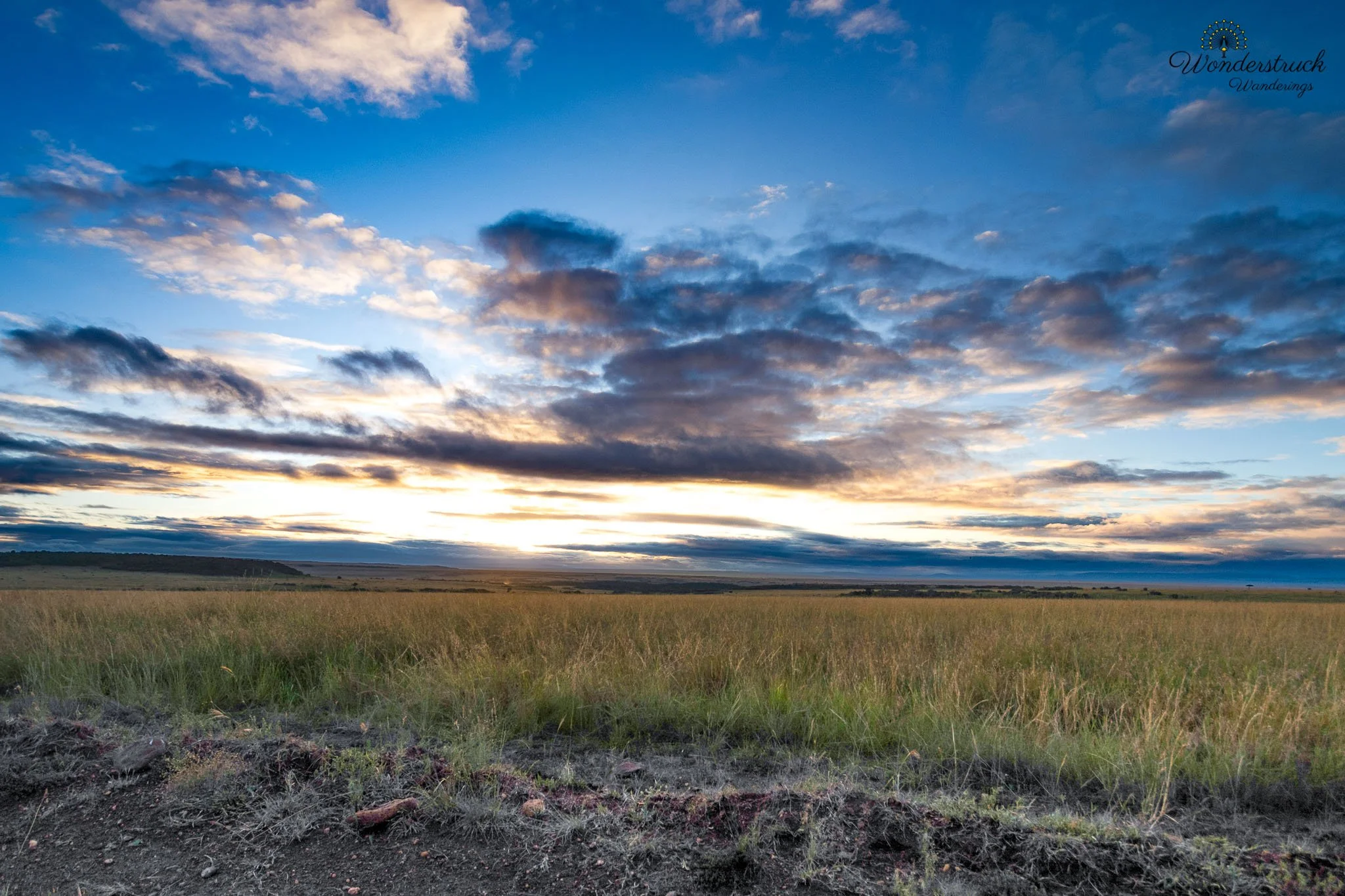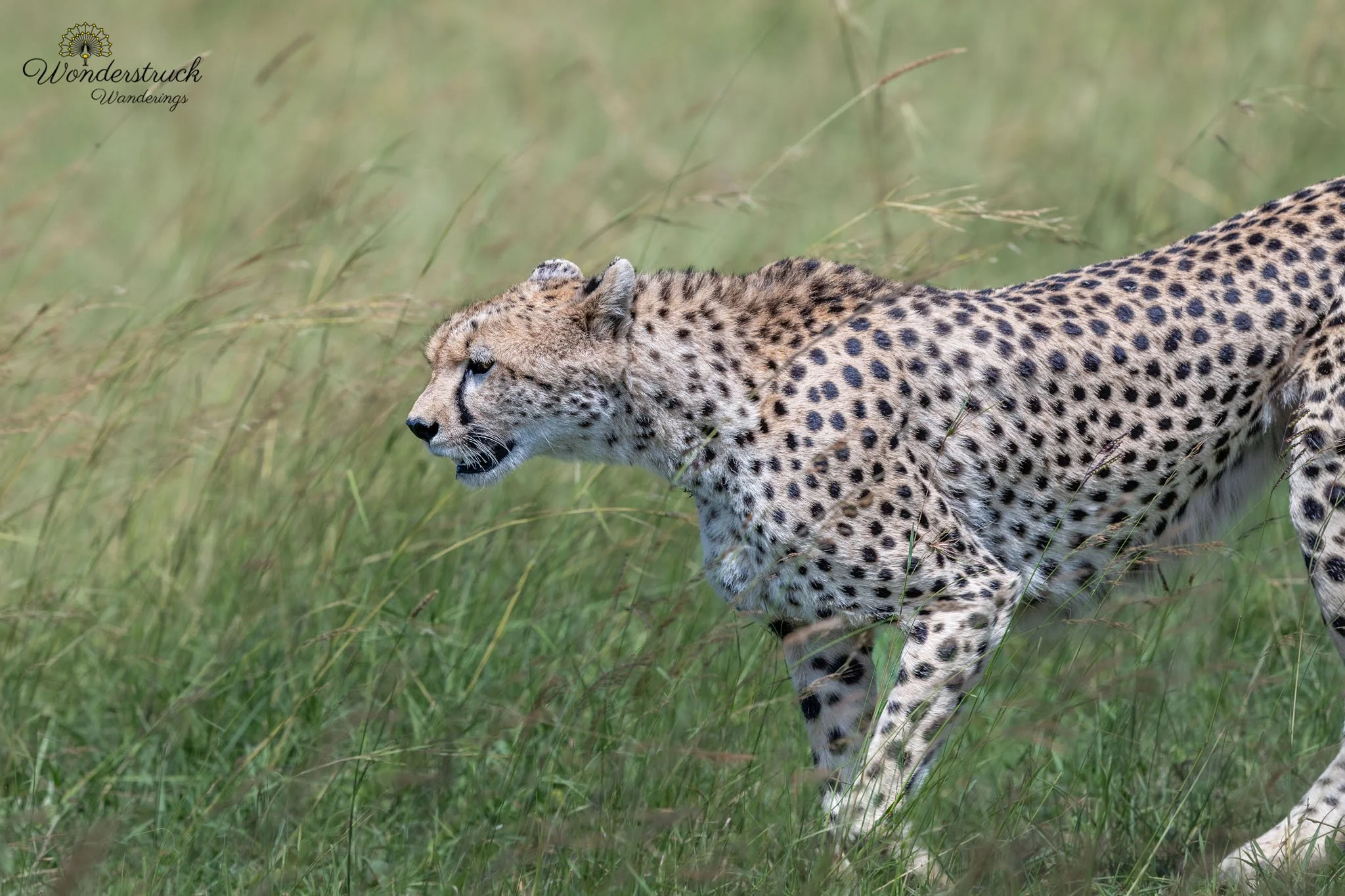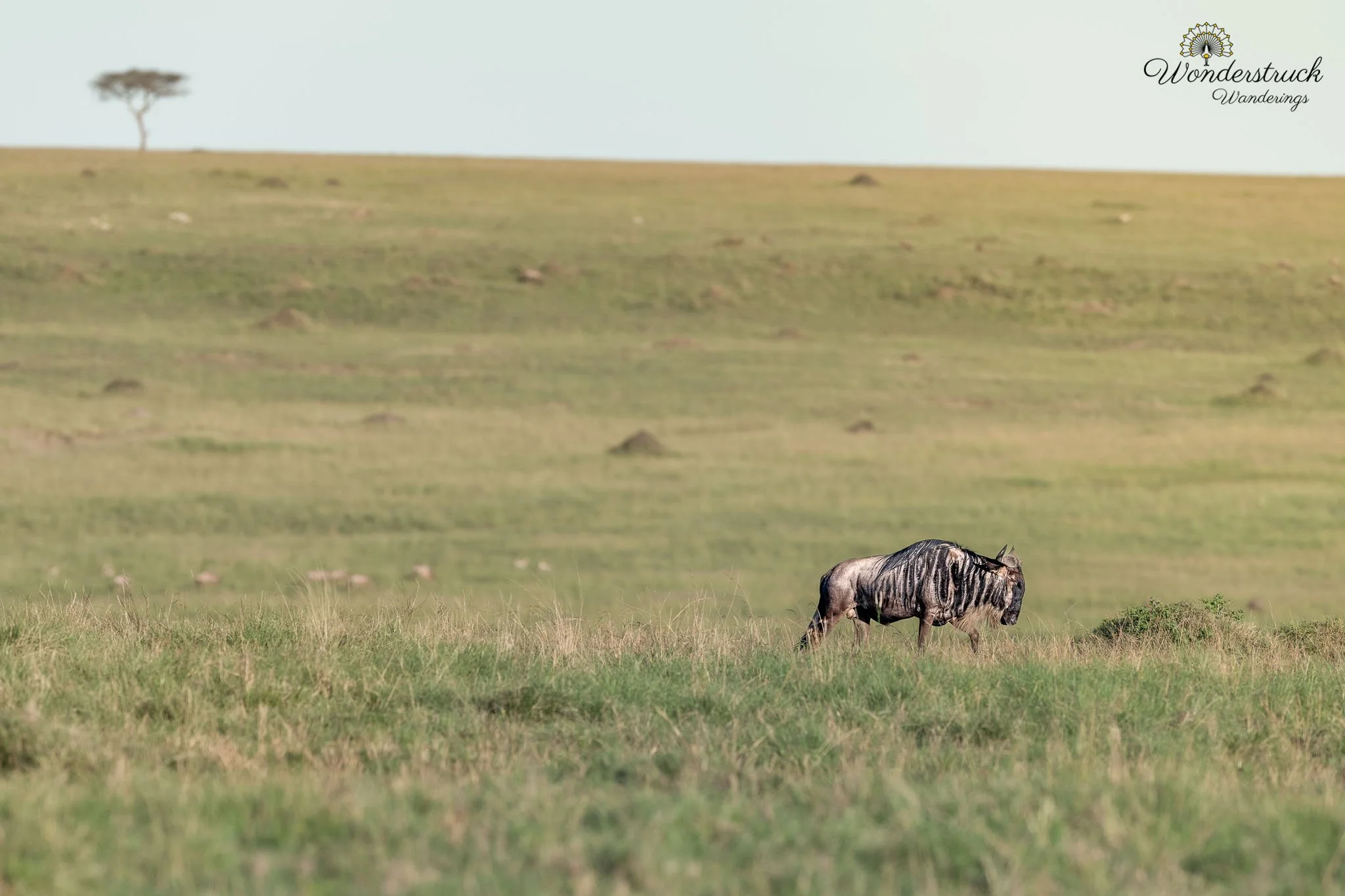Exploring Masai Mara ,chasing Cheetah’s (Day 4)
Another day, another glorious sunrise. We packed our breakfast like the previous days but we had a different plan. The goal was to try to find a cheetah and follow it around to witness a hunt. Growing up watching numerous National Geographic shows, we had wanted to catch the hunt happen but most importantly we wanted to get a glimpse of the cheetah run/jump with all its fours in the air. Oh what a grand iconic shot we were dreaming to experience.
The early morning safari drives in the Masai Mara were pure magic. As the first light of dawn gently broke, the sun rose shyly behind a veil of clouds, casting soft golden hues across the endless savannah. The cool air carried the earthy scent of dew-soaked grass, and in the distance, hot air balloons drifted silently above the plains, their colorful silhouettes floating against the pastel sky while the zebras grazed in the soft light, and the distant calls of birds echoed across the landscape.
As the sun began to rise and speckles of daylight started filling out the skies, we spotted a cheetah sitting on a termite hill beside a tree contemplating whether to hunt or not. While most African cats are nocturnal hunters, cheetahs do things a little differently. Cheetahs are considered “crepuscular” hunters, meaning they hunt at dawn and dusk. They most often hunt between 6:00 and 10:00 in the morning, and 16:00 and 18:00 in the evening. Some of the species they hunt include gazelle, springbok, and impala.One of the main explanations scientists have uncovered for why cheetah hunt during the day is the absence of other large, nocturnal predators. Predation plays a major role in shaping animal behaviors. Though cheetahs themselves are predators, they are also prey to larger, stronger African predators. This means they make decisions that will allow them to eat while avoiding being on someone else’s menu.
Dennis mentioned that it looked like a hungry cheetah indeed, so it would be a great idea to wait and see what he wanted to do. We have all the patience in the world, so the agreement happened by default. By that time, a couple of other jeeps had started gathering, but many did not want to spend much time with the smallest big cat and so they started moving. Soon enough the cheetah started moving, and we started following but in no time it went into the bushes. We thought of looking for it but Dennis heard that a male lion had been spotted so we decided to go see him. He also observed that the cheetah will definitely come out soon because it was on the hunt. Therefore we would come back to our “cheetah search & follow” after looking at the lion. And so we did that.
After taking in the male lion’s company for a little while, we left to continue on with our “cheetah mission”. In no time we found him, who was very much in his “hunt mode”. We noticed that he was going from termite hill to termite hill like the leopard from our previous day, walking discreetly between the tall grass when it seemed like there was an opportunity. There were topis,impalas and gazelles. At first the cheetah was going parallely to the road but suddenly it started going perpendicular. We took a turn and drove on the L- shaped road so that we could follow him closely. It seemed like his clever plan was to stroll against the direction of the wind, that way his smell would not reach the antelopes. Out of the blue, a lone gazelle had somehow started moving close to the cheetah. It was spotted and the cheetah ran lightning fast. When the gazelle realized that, it started running in the opposite direction to reach the top of a hill. He followed abruptly but there was a clear patch in front of the hill which made him slow down. Only a gazelle can outrun a cheetah, they say. Had it not been for the hill, the kill would have been a success. We saw the cheetah turn back, coming down closer to where we were and perch on a termite hill. Not only had we not seen a cheetah sprint with all its fours in the air, but we saw it sigh and pant for such a long time after its unsuccessful chase. Seeing the hungry cat from so close made us extremely downhearted. Cheetahs are critically endangered and they might be a predator, but they need to eat. Such defeat happens as a part of nature’s cycles, we understand, but we hope that starvation does not lead to the extinction of a species.
Had it not been for the hill, the kill would have been a success. We saw the cheetah turn back, coming down closer to where we were and perch on a termite hill. Not only had we not seen a cheetah sprint with all its fours in the air, but we saw it sigh and pant for such a long time after its unsuccessful chase. Seeing the hungry cat from so close made us extremely downhearted. Cheetahs are critically endangered and they might be a predator, but they need to eat. Such defeat happens as a part of nature’s cycles, we understand, but we hope that starvation does not lead to the extinction of a species.
As we left with a heavy heart, we hoped and prayed hard that our mister cheetah would soon be able to hunt and feed itself, there was news of another female cheetah sighting and thus we started driving towards that area. When we finally saw her, she was perched in the shadow of another AndBeyond jeep. Those guys in the jeep must be euphoric, said one of us!
We watched her to our heart’s content when she moved away from the shade of the jeep and started walking towards a small water pocket. Almost all the jeep had started moving away but we knew how much patience pays. Dennis mentioned that she was a lactating mother who was hunting too and that she really needed to feed. The cubs must have been nearby. We saw her have a good drink (and the photographer clicked away incessantly to capture the iconic composition!). At a nearby tree there were two lilac breasted rollers that were circling and flying around like blue shiny objects. It was literally a very active scene and we could not choose which to experience.
After a good drink, she was rejuvenated and started going towards a herd of antelopes. She targeted a gazelle but there were the bigger topis who recognized her presence and had already alerted the gazelle gang. There were a couple of warthogs near the group of antelopes too but they were aware of the cheetahs presence because of all the ruckus and running around.
Another failed attempt. Another disheartening memory created that morning. We got to experience what we wanted but we were not expecting the outcome to be so sorrowful, especially because the mother cheetah needed to eat so that she could produce milk for her cubs and that she could raise a healthy bunch.
It was past 2pm when we got back to Kichwa Tembo and the chef was waiting to feed us lunch. We decided not to go for the evening safari and just hang out in the camp area to enjoy the surroundings.
After a quick rest and a refreshing shower, we strolled to the bar for a soothing cup of tea. We weren’t the only ones drawn to that spot—the resident vervet monkeys clearly had the same idea. These mischievous little regulars have a notorious reputation for swooping in to snatch sugar bowls from unsuspecting tables, and we witnessed the spectacle firsthand. One cheeky monkey made a daring grab, and we couldn’t help but laugh at the universal love of sweetness, a trait apparently shared by primates of all kinds.
With our tea finished, we set off for a leisurely walk around the grounds. Not far along, we spotted a small group of blue monkeys perched gracefully in the branches. One large male regarded us with a calm, almost philosophical expression, while a female cradled her tiny suckling infant close. Nearby, a sprightly youngster—perhaps a teenage monkey—watched us with curious eyes. Continuing down the path, we came across a lone olive baboon standing broad and alert in the middle of the road, as if asserting its claim over the territory.
As we neared the staff quarters, someone advised us to keep an eye out for tree hyraxes near the kitchen area. True to their word, no sooner had we arrived than a plump, wide-eyed family emerged from the shadows to investigate us as intently as we observed them. Just above, a marabou stork had claimed a treetop perch, settling in for the night with an air of ancient patience.
Taking the stork’s cue, we made our way back toward the pool to watch the sun melt into the horizon, painting the sky in warm shades of gold and crimson. Soon after, we enjoyed a sumptuous Kenyan dinner—rich with local flavors and warmth—before retiring for the night, the sounds of the wild serenading us into sleep.




















































































































































